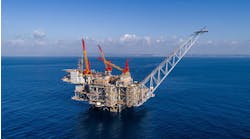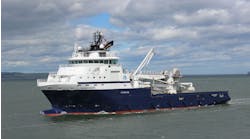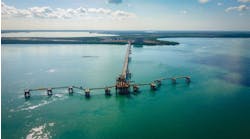Jeremy Beckman • London
Exploration in the Barents Sea is finally delivering the goods. Following Statoil’s Skrugard discovery earlier this year which opened up a new oil play, two other operators have achieved first gas finds in the area.
Total’s came in the Norvarg prospect in license 535, with downhole data suggesting that much of the gas lies in the Kobbe formation. Lundin Norway also proved gas in the Skalle structure, 25 km (15.5 mi) north of the producing Snøhvit field. The discovery within the Kolmule formation proved a new reservoir model, according to partner Spring Energy, and there is upside for more gas and oil at different levels.
In the North Sea, Lundin has confirmed an extension of last year’s Avaldsnes oil find, which could be one of the sector’s largest in recent times. An appraisal well drilled 6.5 km (4 mi) southeast of the discovery well encountered a 13.5-m (44-ft) oil column in Jurassic sandstone. Statoil’s current Aldous exploration well in the same area may reveal a connection with the Avaldsnes structure.
Statoil has also maintained its near-field strike rate, proving oil and condensate via a well on the Krafla West prospect in the North Sea, close to its earlier Krafla discovery. Reserves in the area have been upgraded to 50-75 MMboe, which will probably be tied into the nearby Oseberg facilities.
Norway invites bids for offshore storage
Norway’s Ministry of Petroleum and Energy has launched the first-ever licensing round for carbon dioxide (CO2) storage on the Norwegian shelf. It has invited nominations for areas suited to exploration for subsea reservoirs, which would serve as repositories for CO2.
The Norwegian Petroleum Directorate will manage technical appraisal of the nominated areas. Statoil has stored CO2 offshore for some time in the Sleipner area of the North Sea, and more recently at Snøhvit in the Barents Sea. The impact on reservoir integrity is closely monitored.
UK softens tax blow
Britain’s government has offered a concession to field developers, following the outcry over its raising of the supplementary charge on Corporation Tax on oil and gas production. The Treasury has raised the annual rate of its Ring Fenced Expenditure Supplement (RFES) from 6% to 10%. Developers of marginal fields in particular should benefit.
Industry Association Oil & Gas UK said the change would offset some of the damage caused by the earlier tax increase, announced in March. But it called for further measures to sustain investment in new and existing fields, including clarification over tax relief for decommissioning.
The Oil and Gas Independents’ Association said the RFES measure would provide incentives to currently non-taxpaying companies considering exploration and development on the UK shelf. One relative newcomer to the North Sea, DEO Petroleum, said the change would benefit its Perth field development. Statoil, which had suspended work on its much larger Mariner heavy oil project in the northern UK North Sea, decided to reinstate its program following the announcement. It has since awarded Aker Solutions a topsides front-end engineering design (FEED) study for Mariner.
Revival in sight for Danish exploration
Exploration well numbers on the Danish shelf this year could be the highest in a decade, according to the Danish Energy Agency (DEA). Oil companies budgets suggest over $187 million will be invested, with four to six wells to be drilled in the North Sea. Sweden’s PA Resources should be one of the more active drillers, having submitted plans for two wells in license 12/06 in the southern part of the central graben. Some of the planned wells will test new exploration models, DEA adds.
Denmark’s Minister for Climate and Energy has also asked the agency to prepare for inviting new bids, including currently unlicensed areas, in 2013.
Among the past year’s field development applications came one from DONG Energy for the HP/HT Hejre oil and wet gas field at the northern end of the central graben. According to DEA, the plan calls for a combined accommodation, wellhead and processing platform capable of handling 6,000 cu m/d (37,739 b/d) of oil from five wells, with a subsea pipeline connecting the facility to existing infrastructure. Total costs of the development are estimated at $1.7 billion, with start-up scheduled for 2015. However, DEA is yet to sanction the plan.
DEA has asked DONG to settle its dispute with partner Noreco concerning damage to a subsea caisson connected to the Siri platform, which disrupted production from the field during 2010. DONG had contracted Subsea 7 for a permanent solution which involves installing cable stays between the platform legs and a new seabed support structure connected to the wellhead caisson. But Noreco said it had not sanctioned the $384-million solution, which it claimed was too costly.
BG orders floater for Knarr
BG Norge has commissioned Teekay to supply a turret-moored FPSO for the Knarr oil and gas development in the Tampen area of the Norwegian North Sea. Samsung Heavy Industries will construct the new floater in South Korea, which will have production capacity of 63,000 b/d. The estimated cost is around $1 billion, with the facility due to be delivered in late-2014.
Knarr (formerly Jordbaer) has recoverable reserves of 70 MMboe, which could rise following drilling of nearby prospects. Teekays’s topsides configuration for the FPSO is designed to provide high uptime, and the turret mooring is based on a proprietary technology developed jointly with Framo.
Exit orders issued for two platforms
Statoil has awarded a letter of intent to two contractors to remove redundant North Sea platform structures on behalf of Norwegian gas trunklines operator Gassco. AF Decom Offshore will take out the entire H-7 platform in the German sector, which from 1977-99 served to maintain pressure in the pipeline transporting gas from the Ekofisk complex off southern Norway to a terminal in northern Germany. It will be transported to AF Decom’s yard north of Stavanger for disassembly and scrapping.
Saipem UK will remove the jacket for the former 2/4-S riser platform in the Norwegian sector. The platform began operating in 1985, but became superfluous in 1998 when Statpipe’s gas was re-routed directly into the Norpipe system via the Ekofisk Bypass pipeline. The topsides were removed in 2001 – Saipem will take out the jacket and transport it to shore, with scrapping to be awarded later under a separate contract. Both programs should be implemented by late 2014.
Offshore Articles Archives
View Oil and Gas Articles on PennEnergy.com




